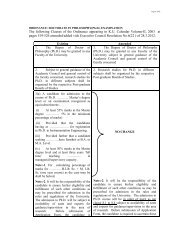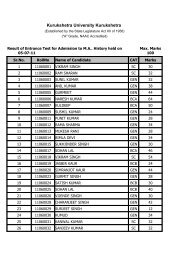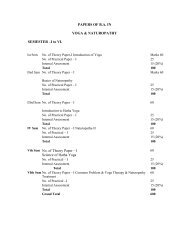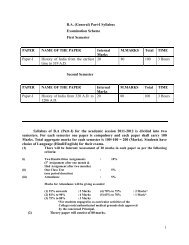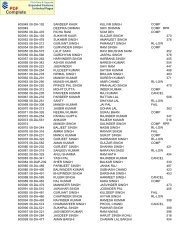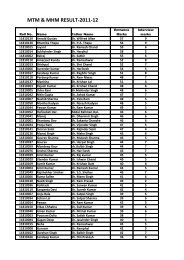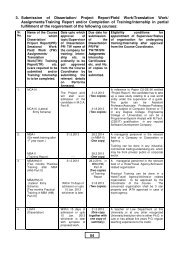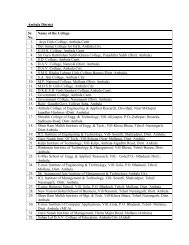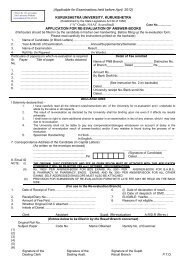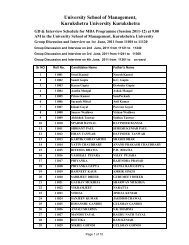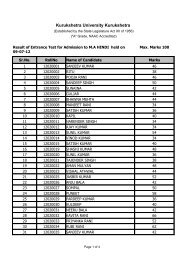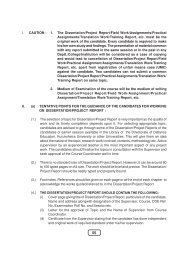STATISTICS PAPER Scheme of Examination of B.A./B.Sc. three year ...
STATISTICS PAPER Scheme of Examination of B.A./B.Sc. three year ...
STATISTICS PAPER Scheme of Examination of B.A./B.Sc. three year ...
Create successful ePaper yourself
Turn your PDF publications into a flip-book with our unique Google optimized e-Paper software.
B.A./ B.<strong>Sc</strong>.I Semester-ITime:3 HoursPaper-II(ST-102)M.M.:B.<strong>Sc</strong>.:40+10*B.A.: 28+7** Internal AssessmentProbability TheoryNote: There will be nine questions in all. Question No.1 will be compulsory coveringwhole <strong>of</strong> the syllabus and comprising 5 to 8 short answer type questions. Rest <strong>of</strong> theeight questions will be set from the <strong>three</strong> sections. The candidate will be required toattempt five questions in all selecting at least one question from each section includingthe compulsory one. All the questions will carry equal marks except the compulsoryquestion, the distribution <strong>of</strong> marks for which will be as follows: B.<strong>Sc</strong>.8 marks and B.A.6 marks.Section-I (Three questions)Concepts in Probability: Random experiment, trial, sample point, sample space,operation <strong>of</strong> events, exhaustive, equally likely and independent events; Definition <strong>of</strong>probability-classical, relative frequency, statistical and axiomatic approach,conditional probability. Addition and multiplication laws <strong>of</strong> probability and theirextension to n events. Boole’s inequality; Bayes theorem and its applications.Section-II (Three questions)Random Variable and Probability Functions: Definition <strong>of</strong> random variable,discrete and continuous random variable, probability function, probability massfunction and probability density functions, distribution function and its properties,functions <strong>of</strong> random variables, joint, marginal and conditional probability distributionfunction.Mathematical Expectation: Definition and its properties-moments, addition andmultiplication theorem <strong>of</strong> expectation. Conditional expectation and conditionalvariance.Section-III (Two questions)Generating Functions: Moments generating function, cumulant generating function,probability generating function along with their properties.
Books recommendedSr.No. Title <strong>of</strong> Book Name <strong>of</strong> author Publisher1. Fundamentals <strong>of</strong> Gupta S.C.& Sultan ChandMathematical Kapoor V.K. & SonsStatistics2. Probability for Edward P.J., Ford J.S. Prentice HallStatistical Decision and LinMaking3. Elementary David S. Oxford PressProbability4. Introduction to Hoel P.G. Asia Pub. HouseMathematicalStatistics5. New Mathematical Bansi Lal & Satya PrakashanStatistics Arora S.6. Introduction to Hogg and Craig Prentice HallMathematicalStatistics
B.A./ B.<strong>Sc</strong>.I Semester-IIPaper-I(ST-201)Time:3 Hours M.M.:B.<strong>Sc</strong>.:40+10*B.A.: 28+7** Internal AssessmentStatistical Methods-IINote: There will be nine questions in all. Question No.1 will be compulsory coveringwhole <strong>of</strong> the syllabus and comprising 5 to 8 short answer type questions. Rest <strong>of</strong> theeight questions will be set from the <strong>three</strong> sections. The candidate will be required toattempt five questions in all selecting at least one question from each section includingthe compulsory one. All the questions will carry equal marks except the compulsoryquestion, the distribution <strong>of</strong> marks for which will be as follows: B.<strong>Sc</strong>.8 marks and B.A.6 marks.Section-I (Two questions)Correlation: Concept and types <strong>of</strong> correlation, methods <strong>of</strong> finding correlation - scatterdiagram, Karl Pearson’s Coefficient <strong>of</strong> correlation (r), its properties, coefficient <strong>of</strong>correlation for a bivariate frequency distribution. Rank correlation with its derivation,its merits and demerits, limits <strong>of</strong> rank correlation coefficient, tied or repeated ranks,coefficient <strong>of</strong> determination.Section-II (Three questions)Linear Regression : Concept <strong>of</strong> regression, principle <strong>of</strong> least squares and fitting <strong>of</strong>straight line, derivation <strong>of</strong> two lines <strong>of</strong> regression, properties <strong>of</strong> regressioncoefficients, standard error <strong>of</strong> estimate obtained from regression line, correlationcoefficient between observed and estimated values, distinction between correlation andregression. Angle between two lines <strong>of</strong> regression.Curvilinear Regression: Fitting <strong>of</strong> second degree parabola, power curve <strong>of</strong> the typeY=aX b , exponential curves <strong>of</strong> the types Y=ab X and Y=ae b X .Section-III (Three questions)Multiple Regression: Plane <strong>of</strong> regression, properties <strong>of</strong> residuals, variance <strong>of</strong> theresidual. Multiple and partial correlation coefficients: coefficient <strong>of</strong> multiplecorrelation and its properties, coefficient <strong>of</strong> partial correlation and its properties,multiple correlation in terms <strong>of</strong> total and partial correlations.
Books recommendedSr.No. Title <strong>of</strong> Book Name <strong>of</strong> author Publisher1. Introduction to Mood A.M., Graybill McGraw HillTheory <strong>of</strong>F.A. & Boes D.C.Statistics2. Applied General Croxton F.E., Cowden Prentice HallStatistics D.J. & Kelin S.3. Basic Statistical Cooke, Cramar & Clarke Chapman & HallComputing4. Statistical Methods Snedecor G.W. & Lowa State Uni.Cochran W.G. Press5. Fundamentals <strong>of</strong> Gupta S.C.& Sultan Chand &Mathematical Kapoor V.K. SonsStatistics
B.A./ B.<strong>Sc</strong>.I Semester-IIPaper-II(ST-202)Time:3 Hours M.M.:B.<strong>Sc</strong>.:40+10*B.A.: 28+7** Internal AssessmentProbability DistributionsNote: There will be nine questions in all. Question No.1 will be compulsory coveringwhole <strong>of</strong> the syllabus and comprising 5 to 8 short answer type questions. Rest <strong>of</strong> theeight questions will be set from the <strong>three</strong> sections. The candidate will be required toattempt five questions in all selecting at least one question from each section includingthe compulsory one. All the questions will carry equal marks except the compulsoryquestion, the distribution <strong>of</strong> marks for which will be as follows: B.<strong>Sc</strong>.8 marks and B.A.6 marks.Section-I (Three questions)Bernoulli distribution and its moments, Binominal distribution: Moments,recurrence relation for the moments, mean deviation about mean, mode, momentgenerating function (m.g.f), additive property, characteristic function (c.f), cumulants,probability generating function (p.g.f) and recurrence relation for the probabilities <strong>of</strong>Binominal distribution. Poisson Distribution: Poisson distribution as a limiting case <strong>of</strong>Binomial distribution, moments, mode, recurrence relation for moments, m.g.f., c.f.,cumulants and p.g.f. <strong>of</strong> Poisson distribution, additive property <strong>of</strong> independent Poissonvariates. Negative Binominal distribution: m.g.f. and p.g.f., deduction <strong>of</strong> moments <strong>of</strong>negative binominal distribution from those <strong>of</strong> binominal distribution.Section-II (Two questions)Discrete uniform distribution. Geometric distribution: Lack <strong>of</strong> memory, momentsand m.g.f. Hypergeometric distribution: Mean and variance. Continuous uniformdistribution: Moments, m.g.f., characteristic function and mean deviation.Section-III (Three questions)Normal distribution as a limiting form <strong>of</strong> binominal distribution, chiefcharacteristics <strong>of</strong> Normal distribution; mode, median, m.g.f., c.g.f. and moments <strong>of</strong>Normal Distribution, A linear combination <strong>of</strong> independent normal variates, points <strong>of</strong>inflexion, mean deviation about mean, area property <strong>of</strong> Normal distribution,importance and fitting <strong>of</strong> normal distribution.Gamma distribution: m.g.f., c.g.f., additive property.Beta distribution <strong>of</strong> firstand second kind. Exponential Distribution: m.g.f., moments, lack <strong>of</strong> memory.
Books recommendedSr.No. Title <strong>of</strong> Book Name <strong>of</strong> author Publisher1. Statistics:A Bhat B.R., New AgeBeginner’s Srivenkatramana T. & InternationalText Vol. II Rao Madhava K.S.2. Fundamentals <strong>of</strong> Gupta S.C. & Sultan chandMathematical Kapoor V.K. & SonsStatistics3. Introduction to Kapoor & Sexena. <strong>Sc</strong>handMathematicalStatistics4. Statistics Johnson R. WileyPublishers5. Mathematical Freund’s J.E. Prentice HallStatistics WithApplications
B.A./ B.<strong>Sc</strong>.II Semester-IIIPaper-I(ST-301)Time:3 Hours M.M.:B.<strong>Sc</strong>.:40+10*B.A.: 28+7** Internal AssessmentElementary InferenceNote: There will be nine questions in all. Question No.1 will be compulsory coveringwhole <strong>of</strong> the syllabus and comprising 5 to 8 short answer type questions. Rest <strong>of</strong> theeight questions will be set from the <strong>three</strong> sections. The candidate will be required toattempt five questions in all selecting at least one question from each section includingthe compulsory one. All the questions will carry equal marks except the compulsoryquestion, the distribution <strong>of</strong> marks for which will be as follows: B.<strong>Sc</strong>.8 marks and B.A.6 marks.Section-1 (Two questions)Statistical Estimation: Parameter and statistic, sampling distribution <strong>of</strong> statistic. Pointand interval estimate <strong>of</strong> a parameter, concept <strong>of</strong> bias and standard error <strong>of</strong> an estimate.Standard errors <strong>of</strong> sample mean, sample proportion, standard deviation,Properties <strong>of</strong> agood estimator: Unbiasedness, Efficiency, Consistency and Sufficiency (definition andillustrations).Section-II (Three questions)Methods <strong>of</strong> Estimation: Method <strong>of</strong> moments,method <strong>of</strong> maximum likelihood and itsproperties(without pro<strong>of</strong>).Testing <strong>of</strong> Hypotheses: Null and alternative hypotheses. Simple and compositehypotheses, critical region, level <strong>of</strong> significance, one tailed and two tailed testing,Types <strong>of</strong> errors, Neyman-Pearson Lemma, Test <strong>of</strong> simple hypothesis against a simplealternative in case <strong>of</strong> Binomial, Poisson and Normal distribution.Section-III (Three questions)Large Sample Test: Testing and interval estimation <strong>of</strong> a single mean, singleproportion, difference <strong>of</strong> two means and two proportions. Fisher’s Z transformation.Determination <strong>of</strong> confidence interval for mean and variance.
Books recommendedSr.No. Title <strong>of</strong> Book Name <strong>of</strong> author Publisher1. Statistics:A Hughes A. & Addision WesleyFoundation For Grawoig D.Analysis2. A First Course on Kale B.K. NarosaParametricInference3. Introduction to Mood A.M., Graybill McGraw HillTheory <strong>of</strong> Statistics F.A. & Boes D.C.4. Introduction to Hoel P.G. Asia Pub. HouseMathematicalStatistics5. Mathematical Freund’s J.E. Prentice HallStatistics WithApplications6. Introduction to Hogg and Craig Prentice HallMathematicalStatistics
B.A./ B.<strong>Sc</strong>.II Semester-IIIPaper-II(ST-302)Time:3 Hours M.M.:B.<strong>Sc</strong>.:40+10*B.A.: 28+7** Internal AssessmentSample SurveysNote: There will be nine questions in all. Question No.1 will be compulsory coveringwhole <strong>of</strong> the syllabus and comprising 5 to 8 short answer type questions. Rest <strong>of</strong> theeight questions will be set from the <strong>three</strong> sections. The candidate will be required toattempt five questions in all selecting at least one question from each section includingthe compulsory one. All the questions will carry equal marks except the compulsoryquestion, the distribution <strong>of</strong> marks for which will be as follows: B.<strong>Sc</strong>.8 marks and B.A.6 marks.Section-1 (Two questions)Concepts <strong>of</strong> census and sample survey, basic concepts in sampling. Sampling and Nonsamplingerrors. Principal steps involved in a sample survey; bias, precision andaccuracy, advantages <strong>of</strong> sampling over complete census, limitations <strong>of</strong> sampling,different methods <strong>of</strong> data collection.Section-II (Three questions)Different methods <strong>of</strong> sampling: probability and non probability sampling, simplerandom sampling (SRS) with and without replacement, use <strong>of</strong> random number tables,estimation <strong>of</strong> mean and variance <strong>of</strong> estimated mean, merits and limitations, simplerandom sampling <strong>of</strong> attributes, size <strong>of</strong> simple random sample. Probability proportionalto sample size(pps): Estimation in with replacement pps sampling, comparison withsampling with equal probabilities, sampling without replacement with unequalprobabilities, an alternative expression for variance, comparison <strong>of</strong> with replacementand without replacement schemes.Section-III (Three questions)Stratified random sampling, estimation <strong>of</strong> population mean, variance <strong>of</strong> the estimate <strong>of</strong>population mean <strong>of</strong> stratified random sampling, allocation <strong>of</strong> sample size, proportionalallocation, optimum allocation, comparison <strong>of</strong> stratified random sampling with simplerandom sampling, systematic random sampling and its various results about variance.
Books recommendedSr.No. Title <strong>of</strong> Book Name <strong>of</strong> author Publisher1. Sampling Cochran W.G. Wiley PublishersTechniques2. Sampling Theory Des Raj and Chandok Narosa3. Sample Theory <strong>of</strong> Sukhatme et. all Lowa State Uni.Surveys with Press & IARSApplications4. Survey Sampling Mukhopadhyay P. NarosaPublishingSociety5. Sampling Daroga Singh & New ageTechniques Chaudhry, F.S International
B.A./ B.<strong>Sc</strong>.II Semester-IVPaper-I(ST-401)Time:3 HourM.M.:B.<strong>Sc</strong>.:40+10*B.A.: 28+7** Internal AssessmentParametric and Non-parametric testsNote: There will be nine questions in all. Question No.1 will be compulsory coveringwhole <strong>of</strong> the syllabus and comprising 5 to 8 short answer type questions. Rest <strong>of</strong> theeight questions will be set from the <strong>three</strong> sections. The candidate will be required toattempt five questions in all selecting at least one question from each section includingthe compulsory one. All the questions will carry equal marks except the compulsoryquestion, the distribution <strong>of</strong> marks for which will be as follows: B.<strong>Sc</strong>.8 marks and B.A.6 marks.Section-1 (Three questions)Chi-square distribution: Definition, derivation, moment generating function,cumulant generating function, mean, mode, skewness, additive property , conditions forthe validity, chi-square test for goodness <strong>of</strong> fit. Contingency table, coefficient <strong>of</strong>contingency, test <strong>of</strong> independence <strong>of</strong> attributes in a contingency table.Section-II (Three questions)t and F statistics: Definition and derivation <strong>of</strong> Student’s‘t’, constants <strong>of</strong> t-distribution, limiting form <strong>of</strong> t-distribution. Definition & derivation <strong>of</strong> Snedcor’s F-distribution, constants <strong>of</strong> F-distribution, mode <strong>of</strong> F-distribution. Relationship betweent, f and chi-square distribution. Testing for the mean and variance <strong>of</strong> univariate normaldistributions, testing <strong>of</strong> equality <strong>of</strong> two means and testing <strong>of</strong> equality <strong>of</strong> two variances<strong>of</strong> two univariate normal distributions. Related confidence intervals. Testing for thesignificance <strong>of</strong> sample correlation coefficient in sampling from bivariate normaldistribution.Section-III (Two questions)Nonparametric Tests: Definition <strong>of</strong> order statistics and their distributions, sign testfor univariate and bivariate distribution, run test, median test, Kolmogorove-Simrnovone sample test, Kolmogorove-Simrnov two sample test, Mann Whitney U-test(onlyapplications without derivation).
Books recommendedSr.No. Title <strong>of</strong> Book Name <strong>of</strong> author Publisher1. Introduction to Feller W. Wiley PublisherProbability andIts Application2. Fundamentals <strong>of</strong> Goon A.M., Gupta M.K. World PressStatistics, Vol. I & Dasgupta B. Calcutta3. Random Variable Cramer H. Cambridge Uni.and ProbabilityPressDistribution4. Fundamentals <strong>of</strong> Gupta S.C. & Sultan chandMathematical Kapoor V.K. & SonsStatistics5. Practical W.J. Conover Wiley PublisherNonparametric
B.A./ B.<strong>Sc</strong>.II Semester-IVPaper-II (ST-402)Time:3 Hours M.M.:B.<strong>Sc</strong>.:40+10*B.A.: 28+7** Internal AssessmentDesign <strong>of</strong> ExperimentNote: There will be nine questions in all. Question No.1 will be compulsory coveringwhole <strong>of</strong> the syllabus and comprising 5 to 8 short answer type questions. Rest <strong>of</strong> theeight questions will be set from the <strong>three</strong> sections. The candidate will be required toattempt five questions in all selecting at least one question from each section includingthe compulsory one. All the questions will carry equal marks except the compulsoryquestion, the distribution <strong>of</strong> marks for which will be as follows: B.<strong>Sc</strong>.8 marks and B.A.6 marks.Section-1 (Three questions)Analysis <strong>of</strong> variance (ANOVA): Definition, assumptions for ANOVA test, one-wayand two-way classifications for fixed effect model with one observation per cell.Introduction to design and experiment, terminology, Experiment, treatment,experimental unit, blocks, experimental error, replication, precision, efficiency <strong>of</strong> adesign, need for design <strong>of</strong> experiments, size and shape <strong>of</strong> plots and blocks.Section-II (Three questions)Fundamental principles <strong>of</strong> design, randomization, replication and local control,completely randomized design, randomized Block Design, their layout, statisticalanalysis, applications, advantages, dis-advantages and efficiency <strong>of</strong> RBD relative toCRD.Section-III (Two questions)Latin square design (LSD) standard Latin square design, layout <strong>of</strong> LSD, its statisticalanalysis, applications, merits and de-merits. Factorial designs- 2 2 and 2 3 designs,illustrations, main effects and interaction effects, Yate’s method for computing mainand interaction effects.
Books recommendedSr.No. Title <strong>of</strong> Book Name <strong>of</strong> author Publisher1. Design and Analysis Das M.N. & Giri Springer VerlageOf Experiments2. Linear Models Searle S.R. John Wiley &Sons3. Linear Estimation Joshi D.D. Wiley EasternAnd Design <strong>of</strong>Experiments4. Fundamentals <strong>of</strong> Gupta S.C. &. Sultan ChandApplied Statistics Kapoor V.K. & Sons
Time:3 HoursB.A./ B.<strong>Sc</strong>.III Semester-VApplied StatisticsPaper-I(ST-501)M.M.:B.<strong>Sc</strong>.:40+10*B.A.: 28+7** Internal AssessmentNote: There will be nine questions in all. Question No.1 will be compulsory coveringwhole <strong>of</strong> the syllabus and comprising 5 to 8 short answer type questions. Rest <strong>of</strong> theeight questions will be set from the <strong>three</strong> sections. The candidate will be required toattempt five questions in all selecting at least one question from each section includingthe compulsory one. All the questions will carry equal marks except the compulsoryquestion, the distribution <strong>of</strong> marks for which will be as follows: B.<strong>Sc</strong>.8 marks and B.A.6 marks.Section-1 (Two questions)Index Number: Definition, problems involved in the construction <strong>of</strong> index numbers,calculation <strong>of</strong> index numbers-simple aggregate method, weighted aggregates method,simple average <strong>of</strong> price relatives, weighted average <strong>of</strong> price relatives, link relatives,chain indices, value index numbers, price and quantity index numbers, Laspeyre’s,Paasche’s, Marshall-Edgeworth and Fisher’s index numbers, time and factor reversaltests <strong>of</strong> index numbers, consumer price index number and its uses. Base shifting,splicing and deflating <strong>of</strong> index numbers.Section-1I (Three questions)Time series Analysis : Definition, components <strong>of</strong> time series-trend, seasonalvariations, cyclic variations, irregular component, illustrations, additive andmultiplicative models, determination <strong>of</strong> trend-graphic method, semi-averages method,method <strong>of</strong> curve fitting by principle <strong>of</strong> least squares, growth curves and their fitting,moving average method. Analysis <strong>of</strong> seasonal fluctuations, construction <strong>of</strong> seasonalindices using method <strong>of</strong> simple averages, ratio to trend method, ratio to movingaverage method and link relative method.Section-III (Three questions)Demographic methods : sources <strong>of</strong> demographic data-census, resigter, adhoc survey,hospital records, measurement <strong>of</strong> mortality, crude death rate, specific death rate,standardized death rates, complete life tables and its main features, assumptions,descriptions and construction <strong>of</strong> life tables, uses <strong>of</strong> life tables, stationary and stablepopulation, measurement <strong>of</strong> fertility-crude birth rate, general fertility rate, specificfertility rate, total fertility rate, measurement <strong>of</strong> population growth, gross reproductionrate, net reproduction rate.
Books recommendedSr.No. Title <strong>of</strong> Book Name <strong>of</strong> author Publisher1. Applied General Croxton F.E., Cowden Prentice HallStatistics D.J. & Kelin S.2. Demography Cox P.R. Cambridge Uni.Press3. Technical Ramakumar R. New AgeDemography International4. Fundamentals <strong>of</strong> Gupta S.C. & Sultan ChandApplied Statistics Kapoor V.K. & Sons
B.A./ B.<strong>Sc</strong>.III Semester-VPaper-II(ST-502)Time:3 Hours M.M.:B.<strong>Sc</strong>.:40+10*B.A.: 28+7** Internal AssessmentNumerical Methods and Fundamentals <strong>of</strong> ComputersNote: There will be nine questions in all. Question No.1 will be compulsory coveringwhole <strong>of</strong> the syllabus and comprising 5 to 8 short answer type questions. Rest <strong>of</strong> theeight questions will be set from the <strong>three</strong> sections. The candidate will be required toattempt five questions in all selecting at least one question from each section includingthe compulsory one. All the questions will carry equal marks except the compulsoryquestion, the distribution <strong>of</strong> marks for which will be as follows: B.<strong>Sc</strong>.8 marks and B.A.6 marks.Section-I (Three questions)Numerical Methods: Concept <strong>of</strong> intrapolation and extrapolation, difference tables,methods <strong>of</strong> interpolation, Newton’s formula for forward and backward interpolationwith equal intervals, Lagrange’s method <strong>of</strong> interpolation, Divided differences,numerical integration, General Quadrature formula for equidistant ordinates,Trapezoidal rule, Simpson’s rd1/3 and th3/8 formula.Section-II (Two questions)Basic <strong>of</strong> Computer: Introduction, origin, development, uses and limitation <strong>of</strong>computers. Types <strong>of</strong> computers, computer structure, input-unit, CPU, output unit,secondary storage, High Level and low level languages, compiler and interpreter.Computer Arithmetic: Floating point representation <strong>of</strong> numbers, arithmetic operationswith normalized floating point numbers. Number systems- Binary, decimal, octal andhexadecimal number systems and their conversions into each other. Binaryarithmetic’s, (Addition, subtraction, multiplication & division).Section-III (Three questions)Flow charts and Algorithm: Concepts <strong>of</strong> flow chart, algorithm and programming. Flowcharts and algorithms for the following: Mean, Standard Deviation, Coefficient <strong>of</strong>Correlation, Straight line fitting. Trapezoidal rule, Simpson’s 1/3 and 3/8 t h rules.
Books recommendedSr.No. Title <strong>of</strong> Book Name <strong>of</strong> author Publisher1. Computer Sinha P.K. BPB PublicationFundamentals2. Introductory Sastry S.S. Prentice HallMethods <strong>of</strong>NumericalAnalysis3. Computer Based Krishnamurthy E.V. Affiliated EastNumerical & Sen S.K. West PressAlgorithms4. Computer Oriented Rajaraman V. Prentice HallNumerical Methods
B.A./ B.<strong>Sc</strong>.III Semester-VIPaper-I(ST-601)Time:3 Hours M.M.:B.<strong>Sc</strong>.:40+10*B.A.: 28+7** Internal AssessmentStatistical Quality ControlNote: There will be nine questions in all. Question No.1 will be compulsory coveringwhole <strong>of</strong> the syllabus and comprising 5 to 8 short answer type questions. Rest <strong>of</strong> theeight questions will be set from the <strong>three</strong> sections. The candidate will be required toattempt five questions in all selecting at least one question from each section includingthe compulsory one. All the questions will carry equal marks except the compulsoryquestion, the distribution <strong>of</strong> marks for which will be as follows: B.<strong>Sc</strong>.8 marks and B.A.6 marks.Section-I (Three questions)Statistical Quality Control : Meaning and uses <strong>of</strong> SQC, causes <strong>of</strong> variations inquality, product and process control, control charts, 3- σ control limits, control chartfor variables- X and R chart, criteria for detection <strong>of</strong> lack <strong>of</strong> control in X & R Charts,Interpretation <strong>of</strong> X & R charts, control chart for standard deviation ( σ charts), controlcharts for attributes- p and c charts, concept <strong>of</strong> 6- σ limits.Section-II (Three questions)Acceptance sampling : Problem <strong>of</strong> lot acceptance, stipulation <strong>of</strong> good and bad lots,producer’s and consumers risks, single and double sampling plans, their OC functions,concepts <strong>of</strong> AQL, LTPD, AOQL, average amount <strong>of</strong> inspection and ASN function.Section-III (Two questions)Demand Analysis : Laws <strong>of</strong> demand and supply, price elasticity <strong>of</strong> demand, demandfunction with constant price elasticity, partial elasticties <strong>of</strong> demands (income elasticity& cross elasticity), types <strong>of</strong> data required for estimating elasticities, family budgetdata, time series data, Leontief’s and Pigous’s methods (from time series data) toestimate demand functions. Engel’s law, Pareto’s Law <strong>of</strong> income distribution, curves<strong>of</strong> concentration, Lorenz curve and Gini’s coefficient.
Books recommendedSr.No. Title <strong>of</strong> Book Name <strong>of</strong> author Publisher1. Statistical Quality Grant E.L. McGraw HillControl2. Statistical Methods Cowden D.J. Asia Pub.in Quality Control Society3. Statistical Theory Brownlee K.A. John Wiley &and Methodology Sonsin <strong>Sc</strong>ience &Engineering4. Engineering Bowker H.A. & Prentice HallStatisticsLiberman G.T.5. Fundamentals <strong>of</strong> Gupta S.C. & Sultan ChandApplied Statistics Kapoor V.K. & Sons6. Fundamentals <strong>of</strong> Goon A.M., Gupta M.K. World PressStatistics, Vol. II & Dasgupta B. Calcutta
Time:3 HoursB.A./ B.<strong>Sc</strong>.III Semester-VIOperations ResearchPaper-II(ST-602)M.M.:B.<strong>Sc</strong>.:40+10*B.A.: 28+7** Internal AssessmentNote: There will be nine questions in all. Question No.1 will be compulsory coveringwhole <strong>of</strong> the syllabus and comprising 5 to 8 short answer type questions. Rest <strong>of</strong> theeight questions will be set from the <strong>three</strong> sections. The candidate will be required toattempt five questions in all selecting at least one question from each section includingthe compulsory one. All the questions will carry equal marks except the compulsoryquestion, the distribution <strong>of</strong> marks for which will be as follows: B.<strong>Sc</strong>.8 marks and B.A.6 marks.Section-I (Two questions)Objective <strong>of</strong> O.R., nature and definitions <strong>of</strong> O.R., <strong>Sc</strong>ope <strong>of</strong> O.R., Meaning andnecessity <strong>of</strong> O.R. models, classification <strong>of</strong> O.R. models, Advantages & disadvantages<strong>of</strong> O.R. models. Steps in model formulation, principles <strong>of</strong> modeling. Characteristics <strong>of</strong>a good model, Allocation problems, General linear programming problem, formulation<strong>of</strong> G.L.P.P., (formulation only for Transportation problem, trim loss problem, productmix problem, Diet problem).Section-II (Three questions)Linear programming problem; definition, objective function, constraints, graphicalsolution <strong>of</strong> L.P.P., limitations <strong>of</strong> graphical method, simplex method to solve L.P.P.,concept <strong>of</strong> initial basic feasible solution, computation procedure for Simplex method.Big-M method (Not included the case <strong>of</strong> degeneracy) unrestricted variables.Section-III (Three questions)Transportation Problem(T.P.), Formulation <strong>of</strong> T.P., B.F.S. <strong>of</strong> T.P., Different methodsto find initial feasible solution, North-West corner rule, Row minima method, columnminima method, Matrix minima method (Least cost entry method), Vogel’sApproximation method (or Unit cost penalty method). UV-method (Modi-method) forfinding the optimum solution <strong>of</strong> T.P.
Books recommendedSr.No. Title <strong>of</strong> Book Name <strong>of</strong> author Publisher1. Operations Hillier F.S. & Tata McGrawResearch Lieberman G.J. Hill2. Linear Hadley G. NarosaProgramming3. Operations Taha H.A. Macmillan Pub.Research:An Co.Introduction4. Operations Goel B.S. & Mittal S.K. PragatiResearch Prakashan5. Operations Sharma S.D. KedarNath &ResearchCo.6. Operations Sharma J.K. Macmillan Pub.Research
B.A./B.<strong>Sc</strong>.-IPaper-III(Practical ST-203)Time: 3 Hours Max. Marks: B.<strong>Sc</strong>.:100PracticalNote: Five questions will be set. The candidate will be required to attemptany <strong>three</strong>.B.A.: 601. To construct frequency distributions using exclusive and inclusive methods2. Representation <strong>of</strong> data using Bar and pie diagrams3. Representation <strong>of</strong> data using Histogram, Frequency Polygon, Frequency Curveand Ogives.4. To toss a coin atleast 100 times and plot a graph <strong>of</strong> heads with respect to number<strong>of</strong> tosses.5. To compute various measures <strong>of</strong> central tendency and dispersion.6 To obtain first four moments for the given grouped frequency distribution.7 To apply Charlier’s checks while computing the moments for a givenfrequency distribution.8. To obtain moments applying Sheppard’s correction.9. To obtain various coefficients <strong>of</strong> skewness and kurtosis.10. To discuss the association <strong>of</strong> attributes for a 2x2 contingency table using Yule’scoefficient <strong>of</strong> association and colligation.11. To compute Karl Pearson’s coefficient <strong>of</strong> correlation for given bivariatefrequency distribution.12. To find Spearman’s rank correlation coefficient for given data.13. To fit the straight line for the given data on pairs <strong>of</strong> observations.14. To fit the second degree curve for the given data.15.bTo fit the curve <strong>of</strong> the type Y = aX for the given data on pairs <strong>of</strong>observations.16. To obtain the regression lines for given data.19 To compute partial and multiple correlation coefficients for the giventrivariate data.20. To obtain plain <strong>of</strong> regression for the given trivariate data.21. To fit binomial distribution to given data.22. To fit Poissonl distribution to given data.23. To fit normal distribution to given distribution using area under thenormal curve.24. To fit normal distribution to given distribution using method <strong>of</strong> ordinates.Distribution <strong>of</strong> marks:B.<strong>Sc</strong>. B.A.Class Record : 10 06Viva Voce : 10 06Practicals : 80 48
B.A./B.<strong>Sc</strong>.-IIPaper-III (Practical ST-403)Time: 3 Hours Max. Marks: B.<strong>Sc</strong>.:100PracticalNote: Five questions will be set. The candidate will be required to attemptany <strong>three</strong>.B.A.: 601. To apply large sample test <strong>of</strong> significance for single proportion anddifference <strong>of</strong> two proportions and obtained their confidence intervals.2. To apply large sample test <strong>of</strong> significance for single mean and to obtainedconfidence interval.3. To apply large sample test <strong>of</strong> significance for difference between twomeans and standard deviations.4. To apply t-test for testing single mean and difference between means and toobtain their confidence intervals.5. To apply paired t-test for difference between two means.6 To apply Chi-square test for goodness <strong>of</strong> fit.7 To apply Chi-square test for independence <strong>of</strong> attributes.8. To apply test <strong>of</strong> significance <strong>of</strong> sample correlation coefficient.9. To apply F-test for testing difference <strong>of</strong> two variances.10. To apply sign test for given data.11. To apply Run test for given data.12. To apply Median test for given data.13. To apply Mann Whitney U-test for given data.14. To find standard error <strong>of</strong> estimate <strong>of</strong> population mean in case <strong>of</strong> SRSWR &SRSWOR and comparison <strong>of</strong> these estimates.15. To find standard error <strong>of</strong> estimate <strong>of</strong> population mean in case <strong>of</strong> stratifiedrandom sampling.16. To find standard error <strong>of</strong> estimate <strong>of</strong> population mean in case <strong>of</strong>systematic sampling.19 To perform ANOVA in case <strong>of</strong> CRD and test whether thetreatments/varieties are equally effective.20. To perform ANOVA for an RBD.21. To perform ANOVA for an LSD.22.2To analyze 2 and32 factorial designs.Distribution <strong>of</strong> marks:B.<strong>Sc</strong>. B.A.Class Record :10 06Viva Voce :10 06Practicals :80 48
B.A./B.<strong>Sc</strong>.-IIIPaper-III(Practical ST-603)Time: 3 Hours Max. Marks: B.<strong>Sc</strong>.:100PracticalB.A.: 60Note: Five questions will be set. The candidate will be required to attemptany <strong>three</strong>.1. To construct X and R-chart, and comment on the state <strong>of</strong> control <strong>of</strong> the process.2. To construct p-chart and d-chart, and comment on the state <strong>of</strong> control <strong>of</strong> theprocess.3. To obtain control limits for number <strong>of</strong> defects and comment on the state <strong>of</strong>control plotting the appropriate chart.4. To calculate price and quantity index numbers using the formulae given byLaspyre, Paasche, Marshal-Edgeworth and Fisher.5. To obtain cost <strong>of</strong> living index numbers for the given data using(i)Aggregate Expenditure Method. (ii) Family Budget Method6 To test the given data whether the formulae given by Laspyre, Paasche, Marshal-Edgeworth and Fisher, satisfy reversal tests.7 To work out trends using curve fitting method for given data.8. To work out trends using moving average method for given data .9. To obtain seasonal variation indices using simple average method.10. To obtain seasonal variation indices using ratio to moving average method.11. To calculate the crude and standardized death rates <strong>of</strong> the populationusing Direct Method and Indirect Method regarding one <strong>of</strong> the population asstandard population.12. To calculate the following for the given dataCDR, CBR, Sex/Age SDR,GFR,TFR,GRR,NRR.13. To complete the given incomplete life table by computing variouselements <strong>of</strong> l-ife table.14. To interpolate the required value for the given data using Newton’sForward/backward interpolation formula for equal intervals.15. To interpolate the required value for the given data <strong>of</strong> using Newton’s divideddifference and Lagrange’s interpolation formula.16. To evaluate the integral <strong>of</strong> the type ∫ b f(x) dx usinga(i) Trapezodial rule, (ii) Simpson’s one-third rule(iii) Simpson’s <strong>three</strong>-eight rule17 Fitting <strong>of</strong> Paretos curve to income data.18. Estimation <strong>of</strong> price-elasticity from time series data.Distribution <strong>of</strong> marks:B.<strong>Sc</strong>. B.A.Class Record :10 06Viva Voce :10 06Practicals :80 48



